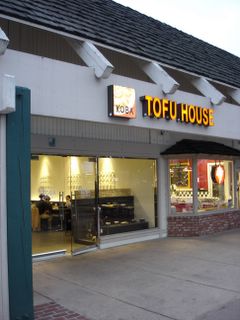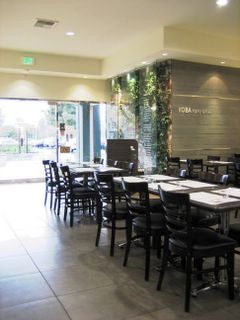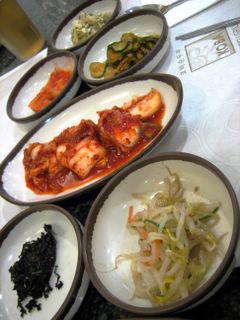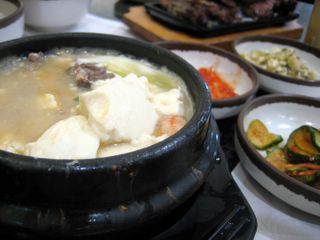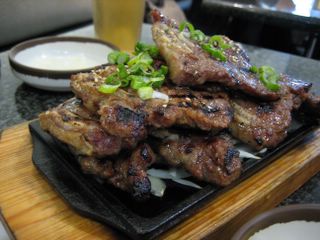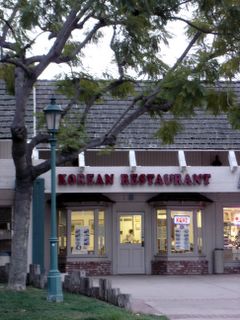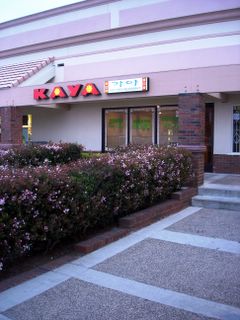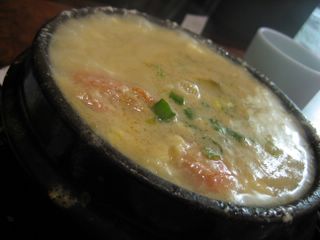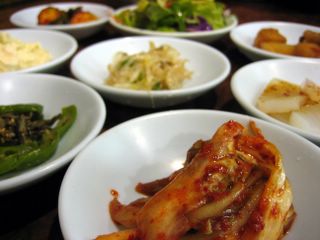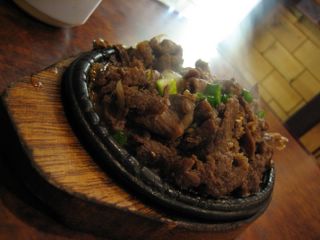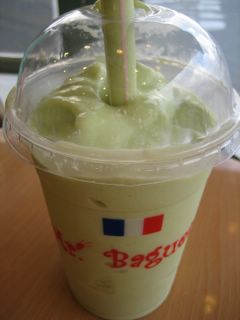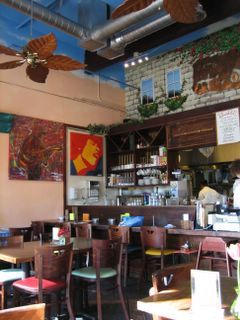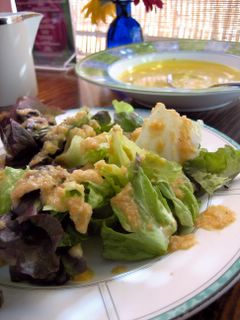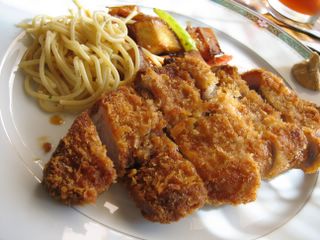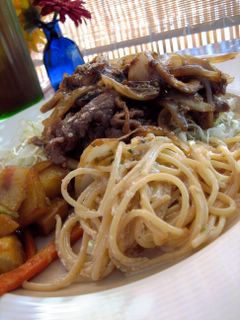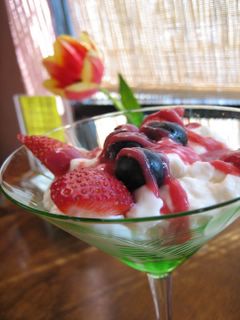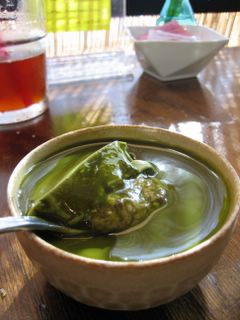Pondok Kaki Lima at the Duarte Inn - Duarte

On a crisp and clear Saturday morning, near the foothills of the San Gabriel Mountains, in the sleepy city of Duarte, behind the low-slung archway of the Duarte Inn, on the grounds of its concrete parking lot, makeshift tents are erected, umbrellas are unfurled, picnic tables are unfolded, and food is prepared.
This is the weekly ritual for the vendors of the Indonesian food fair, known as Pondok Kaki Lima.

The phrase, loosely translated, means "Shack of the Five-Legged Vendor," in a quaint reference to what the residents of this island nation call their food hawkers. To explain the origins of the name: the two front wheels of the traditional food vendor cart, summed with the single wooden peg used for a kickstand and the hawker's own two feet, counts for the five legs in the colloquialism.

The owner of the Duarte Inn, himself an Indonesian, has welcomed a few enterprising home cooks and some ex-restauranteurs to his hotel's backyard to emulate these hawker stands -- in some part to bring the diaspora of Indonesians living in L.A. area together, and in another to share the bounty of the Indonesian kitchen to the general public.
The sense of community in the crowd is palpable, and like a church picnic, people greet each other with sing-song familiarity. And although comparisons will be made to the Wat Thai Temple's weekend food fair, Pondok Kaki Lima is a smaller and more intimate gathering, with only about a half-dozen vendor tents.

On this sunny Saturday morning, business was as brisk as the air. Each stall was swarmed with hungry customers, mostly ex-patriates eager for familiar foods.
One sate vendor, who had propped up three Charbroil grills in a row on his flat bed tow, was squinting behind ribbons of white smoke, feverishly turning the skewered meats over fire, trying to keep up with the orders. Behind him, the low frequency thumps of an unseen boom-box warbled out synthesizer-laden Indo-Pop, with too little treble and an excess of bass.
Another vendor called Kristy Kup, which was a Glendora restaurant before it shuttered its doors, was also particularly busy. They were nearly out of their best-seller, Nasi Gudeg ($6) when we swooped in and took the last order of the afternoon. Their chafing dishes were practically licked clean after our styrofoam container of food was assembled.

Gudeg (pronounced goo-dug) is simmered young jackfruit with a pinkish brown pulp that has the appearance of shredded beef but a flavor that is sweetly floral. Rice always accompanies the dish, but also included is a chicken drumstick, a hard-boiled egg, and a block of dense tofu, all cooked in the same pot.
Nasi Gudeg would not be complete without Sambal Goreng Krecek, a caustic stew of softened beef rinds and chili. Boiled down to a jelly-like consistency, this cooked cow-chiccarone moves and slips around in the mouth, spreading the latent burn of the brew like a mop. If that weren't enough, a dollop of homemade sambal is also served, in case you want to set your whole head on fire.
For snacking, Kristy Kup also sells Pastel Ayam ($1.25 each), the Indonesian version of the empanada. The homemade and braided pastry shell is stuffed which chopped egg, carrots, peas, ground chicken, and bean thread noodle. The parcel is then deep fried to a flaky, golden brown.
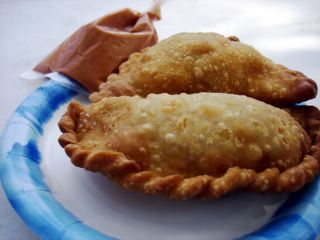
When I ordered mine, the lady directed her husband to fry up a fresh batch. He did so dutifully, taking a few pieces out of a tupperware cointainer, carefully lowering them into a wok, and tossing them in the hot oil.

An order of these Indonesian "Hot Pockets" includes a thick, spicy, and vinegary peanut dipping sauce tied inside a plastic baggie. I immediately took refuge under one of the dining tents and consumed the pastels while still piping hot. It's the perfect finger food -- crunchy, simple, and with every dunk in the sauce, dangerously addictive.

Nasi Rames ($6), bought from another vendor is a combination of four different dishes set around rice. I chose Sambal Telor, which is a deep-fried hard-boiled egg, covered in a sweet but stinging red sauce of tomatoes and chili. Empal, marinated beef fried crisp in oil, tasted like sweet and seasoned jerky, but much more tender and moist. To round out the meal, I also picked out a chicken drumstick, which was stewed in the same sauce as the egg, and simmered kale, a dish that's similar to Southern collard greens in Pot Liquor.

For dessert and to douse the fires now burning a hole on our tongues, we ordered Es Shanghai ($1) from another vendor. It's shaved ice topped with jackfruit, grass jelly, lychees, young coconut, and sweet beans, finished with a generous drizzling of flourescent pink rose syrup and condensed milk.

I took a plastic spoon to task, breaking up the shaved ice mound to distribute the syrup and ingredients into a slush. Slurp after freezing slurp, the dessert cooled my palate and soothed my lips.

Another vendor sold Indonesian groceries, with various items laid out haphazardly on a fold-out table. Krupuk, crunchy fried chips made from tapioca flour, and dark bottles of Kecap Manis, a thick soy sauce sweetened with palm sugar, were in high demand.
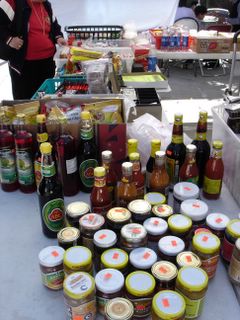
This same stand sold Teh Kotak, which literally translates to "boxed tea," and comes $2 for a pack of six. We bought it as our beverage for the lunch, sucking down the sugary brew through the small straw as chasers to our dessert.

For those who might be interested in experiencing Pondok Kaki Lima but are intimidated with the potential language barrier, I've compiled a small crib sheet with some basic Indonesian to English translations:
Ayam = Chicken
Babi = Pork
Bubur = Rice Porridge
Es = Shaved Ice
Gado Gado = Salad with Peanut Sauce
Goreng = Fried
Kambing = Goat
Lontong = Compressed Rice Cake
Mie = Noodles
Nasi = Rice
Sambal = Chili Paste
Sapi = Beef
Sate = Satay
Siomay = Dumplings
Soto = Spiced Soup
Telor = Egg
Udang = Shrimp
Saturdays from 10 a.m–2 p.m.
Duarte Inn Parking Lot
1200 Huntington Dr
Duarte, CA 91010

